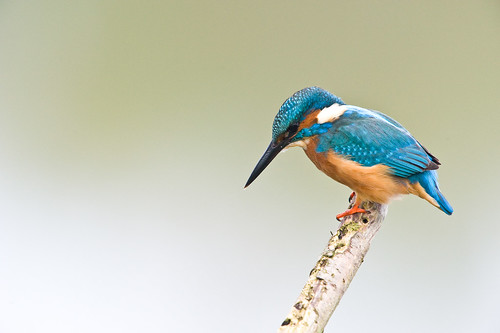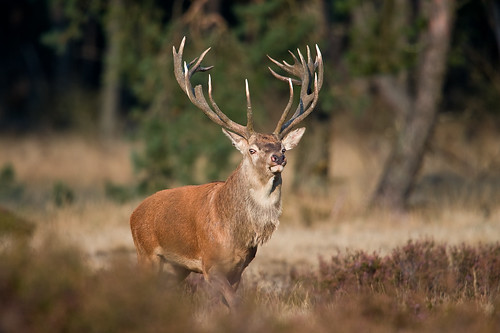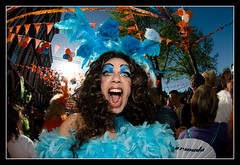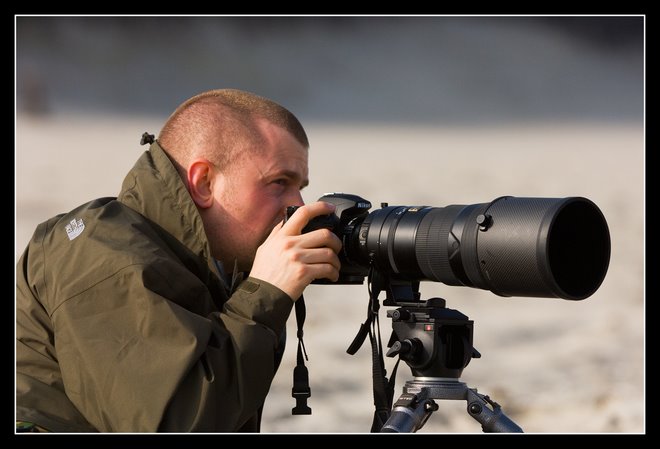The website is at this address
Monday, 17 November 2008
Website updated
Updated my website over the weekend to include some galleries and hopefully let people see more of my work. Still think I need a slightly less basic design, so would welcome any comments, critique, or suggestions where I can go to get a better one made ;)
Friday, 31 October 2008
DRR User? Move your pictures!
Probably not so many readers of my blog are using the services of Digital Railroad, an online photo archiving solution like PhotoShelter, but in case you are, please make sure you know that they have filed for bankruptcy and have given their users until as early as 2359PST on October 31st to move all files off their servers, or risk them being lost for good.
More information on line here
Of course, backing up is an important part of the digital workflow, and it really doesn't help if your chosen online archive goes belly up. Hopefully most users were using DRR purely as a backup facility, and still have a local copy of any files that were online...... hopefully.....
More information on line here
Of course, backing up is an important part of the digital workflow, and it really doesn't help if your chosen online archive goes belly up. Hopefully most users were using DRR purely as a backup facility, and still have a local copy of any files that were online...... hopefully.....
Sunday, 12 October 2008
Kingfisher, Oostvaardseplassen
At the start of the year one of my photographic resolutions was to shoot a kingfisher in 2008.
It took me until October, but today I was finally lucky enough to find a kingfisher that was willing to pose for me. More to come.....
Taken on the D3, 600mm VR with tc-14e, 1/320s @ f/8, 1600iso
It took me until October, but today I was finally lucky enough to find a kingfisher that was willing to pose for me. More to come.....
Taken on the D3, 600mm VR with tc-14e, 1/320s @ f/8, 1600iso
Monday, 22 September 2008
Sunday, 21 September 2008
September 21st 2008: Herd of deer
Light wasn't so great today, so photo opportunities were not as plentiful as the previous days. Plus it's hard to find a different angle to photograph a stag portrait from when you have already taken so many...... :)
Saturday, 20 September 2008
September 20th 2008: Deer Stag, Hoge Veluwe
Day two at Hoge Veluwe. Today we wandered through the woods somewhat unsuccessfully to try and find some mushrooms to photograph, and ended up on the wildbaanweg again in the late afternoon in readiness for the day's rutting.
Still haven't seen any contact rutting, but the stags are getting friskier.

Both shots taken with the D3, 600mm f/4G VR and TC-14e
Still haven't seen any contact rutting, but the stags are getting friskier.

Both shots taken with the D3, 600mm f/4G VR and TC-14e
September 19th 2008: Deer Stag, Hoge Veluwe
Today was our first full day at Natuurcamping Hoge Veluwe after arriving yesterday evening. We quickly discovered that there isn't much wildlife around during the day time, as much of it remains in the woods, which during the rutting season are out of bounds for visitors.
However after around 5pm the deer and stags come out and play. Although it can get pretty busy with a lot of photographers, there are some accessible vantage points along the wildbaanweg where one can get a good picture.
Taken with the D3, 600mm F/4VR with TC-14e, 1/800s, f/5.6, 400iso
Saturday, 17 May 2008
Gear Review: Nikon D3

When Nikon first announced the D3 in August 2007, I told myself I wasn't going to buy one. I thought my reasons were good:
- I do a lot of wildlife photography, so I would miss the crop factor
- Full frame wouldn't really benefit me
- I'm not a pro, and don't need the extra resiliency that the D3 provides
- It's a lot of money to spend on a camera
- Who needs to shoot 9fps ISO6400 anyway?
So, on the day the D3 was announced along with the D300, I went to my local store, and ordered the D300. It also had great high ISO performance, right? And the AF was the same as the D3 in any case.....
But then the D3 was available on the shelves, people started buying it, and reviews appeared on the net. It turns out it's a really great camera! (which, to be honest, looking at the specs I didn't need someone else's review to tell me that). I got thinking, and realised that, based upon the lenses I had, I could sell off most of my DX format stuff, and still have 24-400mm covered. And with the money I would get for all the DX lenses and my two D200 bodies, I would be pretty close to the price of a new D3. So I did it.
My experiences with the D300 up until that point had been very good - the AF system was a significant improvement over the D200, and the lower noise at high ISO was also nothing to be sneezed at. But at concerts I was still uncertain about going above 1250iso, and I still couldn't rival the results coming from even the low end Canon 350d cameras. I decided in any case that I would keep the D300 as my second body, and it still would be used.
Enter the D3.....
The D3 is my first true 'pro' camera, and it oozes quality. From the moment I removed it from the box, it felt 'right' in the hand. All the buttons are in just the right place for my hands, and, although it is a heavier body to what I have been used to, it feels very balanced together with the 24-70mm f/2.8G lens that has become my 'standard' zoom.
The charger (MH-22) and battery (EN-EL4) are a lot more serious looking than then EN-EL3e/MH-18a combo with the D300. The MH-22 will even take two batteries, although they do charge one after another, rather than concurrently. But it does take a while for the battery to charge (around 4 hours), so I was left twiddling my thumbs whilst I waited for the charger to indicate 100%. So, for once, I started to read the instruction manual ;)
So it turned out that there were a number of things that would benefit me from the D3 after all. There has been a lot of discussion on various forums about Nikon's choice to use only 13MP on the full frame sensor, rather than the 20+MP that Canon is currently pushing. However this is where the beauty of the D3 lies - because there are less pixels in the larger sensor size, the individual pixels are bigger, and thus able to gather more light. Which is why the D3 is able to deal with low light conditions so well.

To put this to the test, I took the D3 out for it's first serious work out at the London Calling concert in the Paradiso in Amsterdam. This is a twice annual festival where new bands come over from the UK to try out their sound in front of the Amsterdam music crowd. The gig is split over two rooms, and as one band finishes playing in the 'grote zaal', another band starts upstairs in the 'kleine zaal'. Over the two nights there are over 20 bands playing, so more than enough opportunity to try out my new toy.
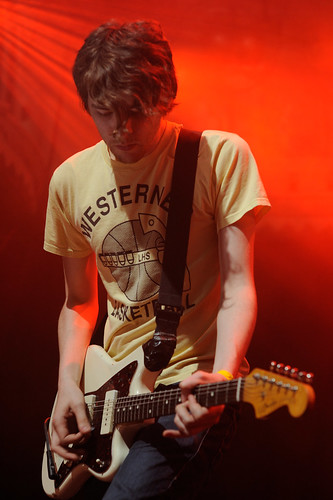
On a whole, I was very happy with the results. On the first evening, in my humble opinion, the lighting conditions were not so good, so I was forced to shoot between 2000 and 4000 iso for the whole evening. And the D3 didn't bat an eyelid. The following shot, of the Mystery Jet's guitarist, was taken at 4000iso, and noise is barely evident.
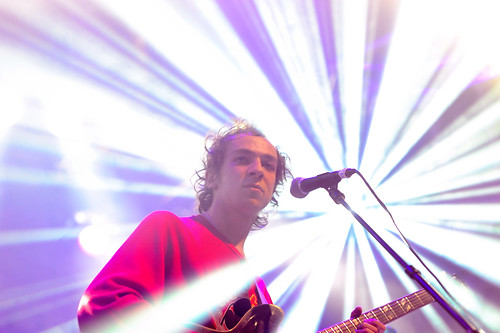
The lighting was improved for the second evening, and I was able to shoot most of the concerts at 1600iso, so the results were understandably clearer. As an example, the first two concert shots in this review were shot at 1600iso. If a professional concert photographer, or other sort of low light photographer, was looking for a new camera, I would have no worries in recommending the D3 for this kind of work.
So the full frame sensor had definitely solved my problem of having poor low light performance, and my secret envy for Canon shooters was no more (and the D3 makes a pretty good weapon in the mosh pit, if necessary)
As you may recall from my previous blog post, with DX format I pretty much always used the 50mm f/1.8D lens at concerts, which, due to the crop factor, acted as a 75mm. So for the D3 a logical choice was to shoot with the 85mm f/1.4D - a lens which did very well for most evenings' shooting. I also had the 50mm in my bag, and switched to it for one band's performance.
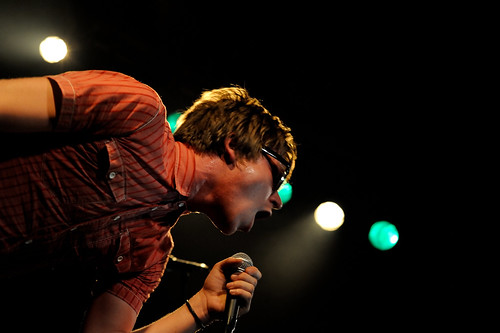
Aside from low light photography, the other area where I was eager to try out the D3 was for wildlife. So I packed up my D3, 200-400mm, and tc-14e and headed off to the Oostvaardersplassen. Here I experienced my first disappointment. Although my 200-400mm had worked very well with the D200 and given sharp results, it turned out that it had front focus issues with the D3. This was something I had already suspected with the D300, although I had not done enough testing to prove that this was the case, but now I had the same issues with the D3, I knew there was a problem. One of the nice features on the D3 is the 'AF fine tune' option. This allows you to move the focus point for a particular lens slightly back or forwards, and adjust the apparent sharpness of the lens. Since I shoot wide open a fair amount, it is very important to me that my lenses are able to focus spot on, and the 200-400mm clearly wasn't doing this.
Unfortunately, it seems that the AF fine tune is only useful for very fine adjustments, as even with fine tune set at the maximum, I still wasn't able to get sharp images at f/4, so I took the lens to my local Nikon service center last Wednesday. It was ready again for collection on Friday (fast service, Nikon!) so I will pick it up on Monday and test it out.
So, that test pronounced a failure, I took advantage of the good weather last weekend, and went along to Apenheul, a large monkey park near Apeldoorn in the Netherlands. I decided to stick with one lens for the day, and chose my 200mm f/2G VR, along with the tc-14e teleconverter in case I needed more length. I concentrated on the smaller monkeys, as these would give the AF more of a test, and I am happy to say I was impressed with the sharpness of the results. All shots were taken wide open or slightly stopped down, so between f/2 and f/4, and all were sharp. Both the golden lion tamarind shots in this review was even shot at 1600iso!
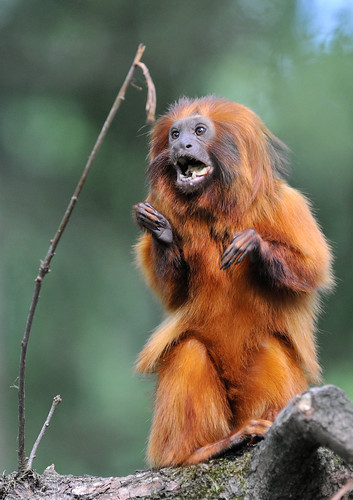
I will also be shooting a couple of weddings later this summer, and this, along with portraiture, is another of the major intended uses for my D3. So I took it along to the wedding of my friends, Cynthia and Stefano. I was there as a guest, and not the official photographer, so I could try it out in a relaxed manner. One of the very usable features on the D3 is the AutoISO functionality. In fairness this function has been on Nikon digital cameras for a while, but I have always avoided using it due to their poorer performance at higher ISOs. But now I can safely set the AutoISO to 3200iso, and choose my minimum shutter speed based upon the lens I am using. I then shoot aperture priority, and if there is not enough light to shoot at my chosen aperture at or above the minimum shutter speed I have specified, the D3 will automagically change the ISO value to compensate.
This worked well for me, and I was able to shoot the whole day at the wedding without messing around with my ISO settings. The below shot was taken in available light at 1600iso
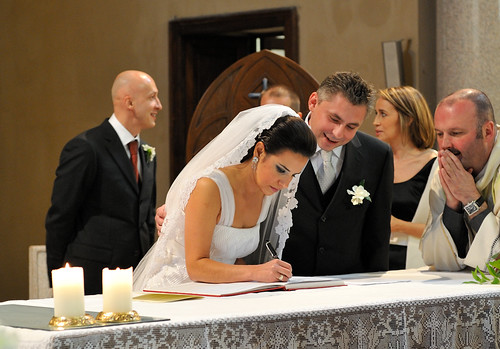
For most of the day I was shooting with the SB-800 speedlight set up to provide fill flash, and again the results were excellent. One thing that has surprised me with the D3 is that in most cases I don't need to make any major adjustments in post processing - the D3 just gets it right first time.

Battery life is also excellent, as should be expected with such a bulky battery, but I don't get anwhere close to the 3000+ shots that Nikon claim. However I think this is more to do with my use of VR lenses, and the chimping that takes place with any new camera than the camera.
Many people on the web have been knocking the D3 because of apparent vignetting (light fall off at the corners) for a number of full frame lenses when used in combination with the D3. The two main culprits here are allegedly the 24-70mm and the 70-200mm VR. Well I have both of these lenses, and have seen no major issues on this front. Maybe there is some sample variation here, but I just don't really experience any problems. Nikon has put a fix for the vignetting problem in the latest firmware update, but I have left that option turned off.
As an introductory offer, Nikon has been giving away a complimentary copy of Nikon CaptureNX with both the D3 and the D300. I have always tried to avoid using NX, as it is such a dog with regards to performance, however I have now started to use it, as it is definitely a better RAW converter for the D3 when compared with Adobe Camera RAW, especially with regards to noise reduction. So from that point, using the D3 has caused my workflow to slow down, but as I stated above, I seem to have managed to configure the D3 to get it right in camera for the most part, so my PP is cut down to a minimum anyway. Using CaptureNX also allows me to take advantage of Nikon's in-camera Active D Lighting, which, based upon my limited testing, is giving me good results.
So all in all, I am happy with the D3. Actually, after one month, I'm very, very, very happy :) It is all the camera I was hoping Nikon would come out with, and I think it will suit me well for a number of years. And with regards to the loss of the crop factor for wildlife photography? Well let's just say there is a little man in a factory in Japan building a 600mm VR with my name on it right now.....
Sunday, 30 March 2008
Gear for Sale
I'm selling a bit of gear to make way for some new toys. I've posted it in a couple of places, and the interest is rolling in, but thought I would put it up here as well......
Nikon D200 with MB-D200 battery grip, 2x EN-EL3e batteries, boxes, and all cables, chargers, etc
I have two of them, each €750, my preference would go to a buyer in Holland or Belgium to avoid hassle of shipping
ONLY ONE REMAINING!
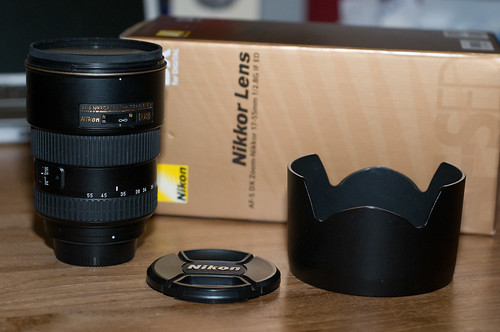
SOLD!!! - Nikon 17-55mm f/2.8G AF-S lens, including box, soft case, lens hood, and Nikon NC 77mm filter.
€900 ono, my preference would go to a buyer in Holland or Belgium to avoid hassle of shipping, but we can discuss this.
Examples taken with this lens at www.flickr.com/photos/digitalheman/tags/1755mmf28g/

SOLD!!! - Nikon 12-24mm f/4G AF-S lens, including box, soft case, lens hood, and Rilex 77mm filter (very high quality filter).
€650 ono, my preference would go to a buyer in Holland or Belgium to avoid hassle of shipping, but we can discuss this.
This lens will go after all the other stuff is sold - I like it too much!...... just let me know if you would be interested
Examples taken with this lens at www.flickr.com/photos/digitalheman/tags/1224mmf4g/

SOLD! - Nikon 60mm f/2.8D Micro-Nikkor lens and Tiffen 62mm filter.
I bought this lens new a couple of years ago, but shot very, very few photographs with it (maybe less than 100), as I picked up a 70-180mm Micro soon after
€250, my preference would go to a buyer in Holland or Belgium to avoid hassle of shipping, but we can discuss this.
All very good condition, selling to make way for new toys :)
I have two of them, each €750, my preference would go to a buyer in Holland or Belgium to avoid hassle of shipping
ONLY ONE REMAINING!

SOLD!!! - Nikon 17-55mm f/2.8G AF-S lens, including box, soft case, lens hood, and Nikon NC 77mm filter.
€900 ono, my preference would go to a buyer in Holland or Belgium to avoid hassle of shipping, but we can discuss this.
Examples taken with this lens at www.flickr.com/photos/digitalheman/tags/1755mmf28g/

SOLD!!! - Nikon 12-24mm f/4G AF-S lens, including box, soft case, lens hood, and Rilex 77mm filter (very high quality filter).
€650 ono, my preference would go to a buyer in Holland or Belgium to avoid hassle of shipping, but we can discuss this.
This lens will go after all the other stuff is sold - I like it too much!...... just let me know if you would be interested
Examples taken with this lens at www.flickr.com/photos/digitalheman/tags/1224mmf4g/

SOLD! - Nikon 60mm f/2.8D Micro-Nikkor lens and Tiffen 62mm filter.
I bought this lens new a couple of years ago, but shot very, very few photographs with it (maybe less than 100), as I picked up a 70-180mm Micro soon after
€250, my preference would go to a buyer in Holland or Belgium to avoid hassle of shipping, but we can discuss this.
All very good condition, selling to make way for new toys :)
Saturday, 15 March 2008
Gear Review: Nikon 10.5mm F/2.8G DX Fisheye lens
A fisheye lens is defined as an ultra-wide lens, giving a close to 180 degree angle of view. There are two sorts of fisheye - a circular, or a full frame fisheye.
Back in the days of film, fisheye lenses were either very cheap (and subsequently rather unsharp) or very expensive, large, and out of the reach of the average photographer.
However, with the advent of the cropped DX sensor, not so much glass was required in order to get the full 180 degree view favored by the full frame fisheye, and Nikon's answer to this was the 10.5mm fisheye, which only works on the DX range of Nikon digital SLRs. (using this on a full frame camera will lead to vignetting, and a fairly unusable image). The 10.5mm is a compact lens of similar diameter to the 50mm F/1.8, and a little bit longer. Due to a bulging front element, the lens has a built in, non removable lens hood.
When I was in the States last year, i picked up the fish for around $600, after looking at it online and wondering whether to buy it in Europe for around €600. $600 was a very good price for this lens, and in fact, having used it for the past year, I would be more than prepared to pay the full €600 for it, should I ever need to replace it.
Images that come from full frame fisheye lenses are easy to spot, due to the curvature that gets applied to straight lines within the frame. Whilst a straight line through the center of either axis will stay straight, anything away from that will be bent to varying degrees, as you can see from the image above.
If you think back to photography 101, you will remember that the wider a lens is, the greater the depth of field in the image, and the 10.5 is no exception to this. So much so, that focusing is almost unnecessary, but with it having a f2.8 maximum aperture and in spite of not having AF-S, focusing happens fast and accurately in any case. It's not a lens for everyday shooting, due to the issues with curvature, but used sparingly, it gives fun images.
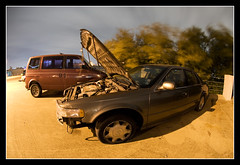
I find the images to be nice and contrasty, with good colors. Due to the large angle of view, light pours into the lens, and it can be handheld at low shutter speeds without noticeable lens blur.
Obviously due to the large angle of view, if you are using the lens as a portrait lens, as I did for the first image, you need to be very close to the subject - I was probably around 50cm from his face. The way I like to shoot when I am using it for portraits is to shoot into the sun, but use a flash either on or off camera to fill in the details in the foreground of the shot.

It is possible to 'defish' the images taken with this lens using Nikon's software, but personally I don't do this. When an image is defished, it is straightened out, and the image no longer fills a rectangle, so cropping is necessary to get it back to a frame filling image, and the edges of the frame are lost. I have other lenses, such as the 12-24mm, that I will use if I want to take an ultra wide shot with limited distortion.
So in summary, this is a fun lens, ideal if you want to give an image an extra level of interest. It does distort images, but that also adds to the image in many ways. Due to it's compact size, it is easy to throw in the bag and carry all the time, just in case the opportunity arises to use it.......
Back in the days of film, fisheye lenses were either very cheap (and subsequently rather unsharp) or very expensive, large, and out of the reach of the average photographer.
However, with the advent of the cropped DX sensor, not so much glass was required in order to get the full 180 degree view favored by the full frame fisheye, and Nikon's answer to this was the 10.5mm fisheye, which only works on the DX range of Nikon digital SLRs. (using this on a full frame camera will lead to vignetting, and a fairly unusable image). The 10.5mm is a compact lens of similar diameter to the 50mm F/1.8, and a little bit longer. Due to a bulging front element, the lens has a built in, non removable lens hood.
When I was in the States last year, i picked up the fish for around $600, after looking at it online and wondering whether to buy it in Europe for around €600. $600 was a very good price for this lens, and in fact, having used it for the past year, I would be more than prepared to pay the full €600 for it, should I ever need to replace it.
Images that come from full frame fisheye lenses are easy to spot, due to the curvature that gets applied to straight lines within the frame. Whilst a straight line through the center of either axis will stay straight, anything away from that will be bent to varying degrees, as you can see from the image above.
If you think back to photography 101, you will remember that the wider a lens is, the greater the depth of field in the image, and the 10.5 is no exception to this. So much so, that focusing is almost unnecessary, but with it having a f2.8 maximum aperture and in spite of not having AF-S, focusing happens fast and accurately in any case. It's not a lens for everyday shooting, due to the issues with curvature, but used sparingly, it gives fun images.

I find the images to be nice and contrasty, with good colors. Due to the large angle of view, light pours into the lens, and it can be handheld at low shutter speeds without noticeable lens blur.
Obviously due to the large angle of view, if you are using the lens as a portrait lens, as I did for the first image, you need to be very close to the subject - I was probably around 50cm from his face. The way I like to shoot when I am using it for portraits is to shoot into the sun, but use a flash either on or off camera to fill in the details in the foreground of the shot.

It is possible to 'defish' the images taken with this lens using Nikon's software, but personally I don't do this. When an image is defished, it is straightened out, and the image no longer fills a rectangle, so cropping is necessary to get it back to a frame filling image, and the edges of the frame are lost. I have other lenses, such as the 12-24mm, that I will use if I want to take an ultra wide shot with limited distortion.
So in summary, this is a fun lens, ideal if you want to give an image an extra level of interest. It does distort images, but that also adds to the image in many ways. Due to it's compact size, it is easy to throw in the bag and carry all the time, just in case the opportunity arises to use it.......
Sunday, 17 February 2008
Book Review: Joe McNally - The Moment It Clicks

The cover of this book claims to teach you "photography secrets from one of the world's top shooter", and 256 pages later, I feel that I have definitely gotten an insight into Joe's work ethic, and understood some of the reasons why the publisher's suggest he is a "legendary magazine photographer.
The book was published in January 2008, and I received it from Amazon (click the picture to be linked through) yesterday. After a busy Saturday, I had a free Sunday, so sat down to read the book. And didn't put it down until I had finished it......
Joe McNally has been a photographer for over 30 years, and his career has been spent shooting for magazines such as Life, People, Time, Sports Illustrated, and National Geographic. In the first two thirds of the book Joe shares these experiences with the reader. In each double page spread he presents a photograph from his portfolio, and describes, in a casual manner, some of his reasoning behind the shot, and how he achieved it technically. Sometimes this is done by relating to the shot itself, and sometimes by describing a conversation he has had or a situation he has been in, and then illustrating it with a photograph. But either way, it makes entertaining reading.
One of Joe's mantras is "the only good light is available light, and by that I mean any light that is available", and he really is the master of off camera lighting. For most of the shots he describes how the scene was lit, whether it be a white sheet from the motel he stayed in the night before ("I am a bed sheet thief") to act as a diffusor on a window, or a combination of softboxes, grids, and snoots.
The final third of the book, after a short description of the gear he uses (he is a Nikon shooter, and has shot many advertisements for them, and also made an instructional Nikon lighting DVD called "The Speed of Light" - worth a watch) covers various experiences he has been in, like the time he threw up 50 times whilst shooting a weightless flight at the Russian space camp, or the time he shot 10 frames of a pro baseball player, before realizing he hadn't advanced his film a single frame. But with each story he illustrates, he always has a message to the reader.
One thing that struck me about Joe is that in almost every shot he shows, he has had to work quickly, with high pressure. Typically his subjects give him around 10 minutes to shoot them, and, although he often spends hours before a shoot setting up his concept, he needs to make sure that his shoot works first time, and if not, the reshoot must take place at the same time. You can definitely see shots where he has made mistakes, or where there are visual errors, but that isn't the point. Keep your eye to the camera at all times, or you will miss a shot, says Joe, and he has stuck true to this.
This book is a definite recommendation for anyone who wants to start out in the field of photojournalism, and wants to hear from someone who has been there, done that, but for everyone else, it is an entertaining read, and there is a lot that any photographer can learn from Joe's musings.
Subscribe to:
Posts (Atom)


